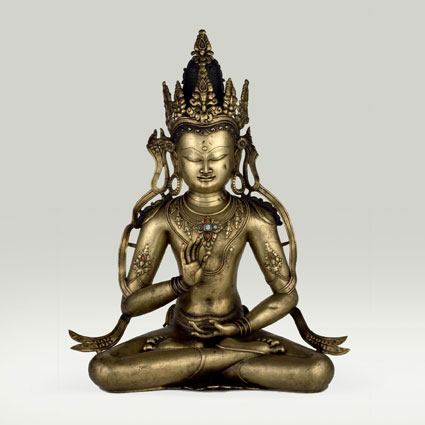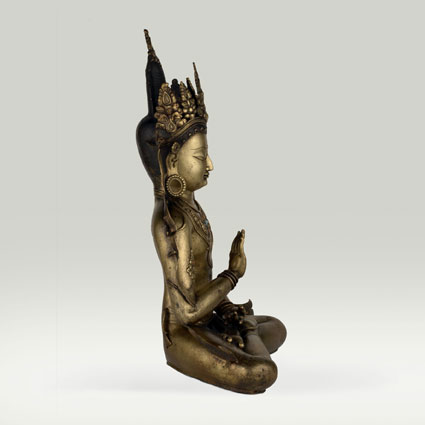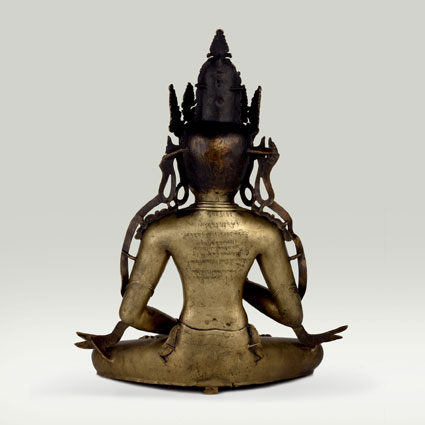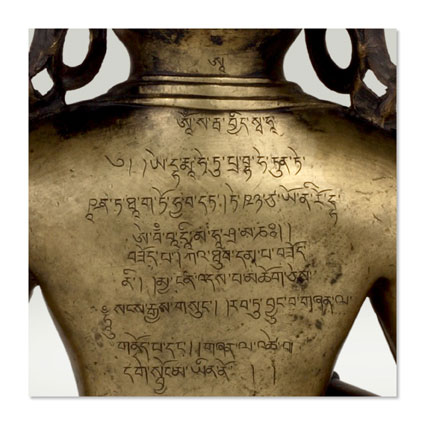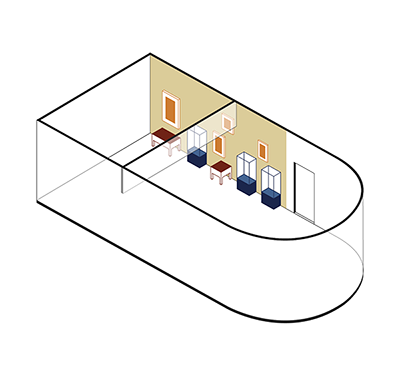
ABS 065
Code: ABS 065
Country: Tibet (west)
Style:
Date: 1200 - 1300
Dimensions in cm WxHxD: 29.9 x 47 x 14.5
Materials: Brass; inset with turquoise and coral
Hollow cast in one piece.
The separately cast pedestal is lost.
Decorated with engraved textile patterns.
The jewelled ornaments are partly inset with turquoise and coral.
The face has traces of painted cold gold and the hair remains of a blue pigment.
The crowned Amoghasiddhi (Tib. Don yod grub pa), which might at one time formed part of a group of the five Tathagatas, is seated in the diamond attitude (vajraparyankasana). He shows with the raised right hand the gesture of fearlessness (abhaya-mudra) and rests the left hand in the lap. The Buddha wears a decorated shawl carried over the left shoulder and tied across the waist. He is decorated with the ornaments of a crowned Buddha, namely a five-pointed crown in front of the tall knot of hair surmounted by the “wish-granting jewel” (cintamani), an intricately worked necklace with attached pendants, ornaments at the upper arms and the wrists, and anklets. The Buddha is encircled by a ribbon-like scarf.
On the back of the head and neck is a vertical Sanskrit mantra inscribed in Tibetan dBu canscript: // OM A· HUM //. On the back is a Sanskrit inscription in dBu can script of the Buddhist creed: // Om sarba bjid svaha / Ye dharma hetu prabhava hetu(n)m tesan(m) tathagato hy ab(v)adat tesam ca yo nirodha evamb(v)adi maharramanau //.
The inscription continues with a standard consecration formula quoting part of a verse also known as pratisamyutpada mantra from the Pratimoksa Sutra and spelled as follows: // bzod pa [d]ka’ thub dam pa bzod ni // myang ngan ’das ba mchog ces sangs rgyas gsung rab tu byung pa gzhan la gnodba dang gzhan la ’tshe ba dges byang my yin no//.
It is very unusual to find such a long inscription on the back of a metal sculpture.
His Amoghasiddhi is certainly one of the finest known Tibetan images of a crowned Buddha and dates from the 13th century.
The essential nature of a bodhisattva or a buddha is that he or she embraces the enlightened qualities of the five buddha families, which pervade every living being without exception, including ourselves.
To achieve the realization of these five buddha families or the five dhyana buddhas, it is necessary to abandon the five disturbing emotions of great attachment, anger or aggression, ignorance or bewilderment, pride and envy. When these disturbing emotions are purified and removed, the five wisdoms shine forth. Realization of the five wisdoms is realization of the five dhyana buddhas. To begin with, we have to understand what the five disturbing emotions (Skt. kleshas) are.
1. The first, which seems to be most powerful, is anger. Anger is an emotion which arises and develops against someone or something one dislikes. If examined carefully, in the short run anger creates pain and in the long run it brings about serious harm. The immediate pain and future harm is to oneself as well as to others is due to the power of one’s own aggression. We therefore need to understand the first negative emotion. The negative emotion of anger causes temporary suffering for oneself and others for this lifetime. This emotion is so powerful that all negative actions or karma accumulated by wishing harm to others can lead one to take rebirth in the lower realms. For example, intense anger can cause rebirth in the lowest hell realm where there is intense suffering. Therefore, anger not only causes suffering and pain in this lifetime, but also causes us to take birth in the lower realms, where even more intense suffering ensues as a result. To be free of the experience of suffering and pain in this lifetime and to be free of the experience of taking birth in a lower realm, it is necessary to employ methods to overcome and eliminate anger and hatred.
When anger is purified and removed, we come to develop and to gradually realize mirror-like wisdom. With mirror-like The Five Buddha Families and the Eight Consciousnesses wisdom, there is no distinction between self and others, there is no separation between self and other phenomena, so everything is experienced in unity and harmony. It is called mirror-like wisdom because phenomena appear to the mind in the same way that things appear in a clean mirror, completely accurate with no distortion. Understanding and realizing mirror-like wisdom takes place in the absence of the negative emotion of anger. Realization of mirror-like wisdom is realization of Buddha Akshobhya, who is blue in color. He holds a vajra in his left hand. His activity is pacifying the emotions, in particular, suffering, illness, frustration, and sorrow.
2. The second dhyana Buddha is the Buddha Ratnasambhava who is realized when the disturbing emotion of pride or ego is purified. Ego is the belief in a self which we all develop from birth as soon as our mind thinks of itself as separate from others. The next three types of pride evolve in this process of selfcenteredness: (1) We feel that we are better than others who are in a less fortunate situation, (2) we feel that we are superior to others because we fail to see the equality of ourself and others; and (3) we feel we are either spiritually or materially better than others. What causes us to embark upon the journey of ego? When the self believes that it is separate from others, the negative emotion of pride arises in which one believes oneself in some way better than others. From this then arises the belief that there are “good” i.e. things which we believe in and do and “bad” i.e. things that others believe in and do. As long as we believe ourselves to be superior to others, it is impossible to learn from them. So we must give up ego clinging to develop enlightened qualities. A purified mind does not distinguish between pure and impure, good and bad, I and others; rather it experiences all things in equality. When one is free from pride, realization of the wisdom of equality dawns and one experiences and becomes Buddha Ratnasambhava.
Buddha Ratnasambhava’s activity is enriching and as a symbol of his activity of enrichment, he is gold or yellow in color. As a symbol of his ability to enrich all living beings, he holds the precious wish-fulfilling jewel in his hands.
3. The third dhyana Buddha represents the purification and elimination of the disturbing emotion of attachment or desire. Desire causes much suffering by being quite distracting and keeping the mind restless and busy. Why? When one is attached to things, one is never satisfied and always craves for more and better things. One is continuously engaged in achieving and acquiring the mind’s desires and only experiences loss and dissatisfaction in one’s life. By understanding this negative emotion and by eliminating it, the third discerning wisdom shines forth. By realizing discerning wisdom, the enlightened mind is experienced, and one becomes one with the Buddha Amitabha. It is with this wisdom that one understands and has empathy with each and every living being and appreciates others’ qualities.
The Buddha Amitabha’s nature is the absence of attachment and desire and his activity is magnetizing. As already said, attachment and desire lead to the suffering of dissatisfaction, a state in which one always wants and strives for more and better things. Desire determines one’s behavior and not attaining what one desires leads to frustration and dissatisfaction. With the discerning wisdom and the realization of Buddha Amitabha, there is no attachment and desire and thus no dissatisfaction or craving for more and better things. This realization is so powerful that all things are naturally magnetized as one’s own. There is no energy and force involved as in a state of desire.
4. The fourth dhyana Buddha is Buddha Amogasiddha. He is realized in the absence of the negative emotion of jealousy which includes being jealous of others’ wealth, success, and good fortune. With jealousy negativity is accumulated. By overcoming jealousy, Amogasiddha and the fourth all accomplishing wisdom are realized. Jealousy prevents and impedes an individual from accomplishing his or her own well-being and as a result he or she experiences more suffering and continues developing further jealousy towards those who have more. This is the reason all accomplishing wisdom is experienced in the absence of jealousy, i.e., when jealousy is removed, all wishes are naturally and effortlessly accomplished. As long as jealousy determines one’s attitude, one is bound to experience more obstacles in achieving personal success and in accomplishing positive goals.
This is why Buddha Amogasiddha’s activity is wrathful. It is with wrath that he removes all obstacles and hindrances preventing spiritual maturation and success. He is green in color, the same color as growing plants symbolizing the numerous activities he employs to remove hindrances.
5. The fifth dhyana Buddha is Buddha Vairocana, who is realized when the negative emotion of ignorance is overcome. Ignorance is failing to recognize what is wholesome and unwholesome, failing to know the ultimate and conventional truth and failing to realize the highest state of dharmata. Ignorance is the root of the negative emotions, so that, for example, it is only out of ignorance that one is angry. One only acts aggressively towards others because one is ignorant that anger will only bring on pain and sorrow to oneself and others. Likewise, it is only due to ignorance that one has pride, desire, and jealousy.
Elimination of the darkness of ignorance is the realization of Buddha Vairocana. The wisdom which shines forth when ignorance is overcome is the wisdom of dharmata, i.e., realization of the highest state. We have failed to realize the true state up until now due to ignorance, and this ignorance causes all the mental confusion and misleading actions. Purification of ignorance engenders realization of the wisdom which sees all things as they really are. The natural body of the purity of the wisdom of dharmata is Buddha Vairocana. Since the darkness of ignorance is eliminated, he is the clear color of white.
Qualities Arising from Transforming Negative Emotions
We have given a brief description of the five dhyana buddhas who represent the purified qualities of the five disturbing emotions. When these five negative emotions are purified, the qualities of the five buddhas shine forth purely.
Buddha Amogasiddha is realization of all-accomplishing wisdom. The Tibetan word for Buddha Amogasiddha is sangay donyodtrubpa. The word danyodmeans “meaningful” and the word trubpameans “accomplishment.” So Buddha Amogasiddha means “whatever is meaningful and fruitful is accomplished.” He is also the complete purification of jealousy, which is a hindrance for both material and spiritual success. His activity is perfect accomplishment and fulfillment of meaningful aims. Furthermore, his activity removes ordinary daily hindrances such as illnesses and obstacles. This is why Ratnasambhava’s activity is meaningful accomplishment.
Buddha Amogasiddha holds a double-vajra in the form of a cross in his left hand, which symbolizes that his activity pervades and touches all directions. He sits in the full lotus posture. The left hand of all five dhyana Buddhas rests in the meditative posture of the changeless realization of dharmata. Amogasiddha’s right hand is in the mudra of fearless protection. He protects all living beings from any mishaps, obstacles, and negative influences. So his posture is known as “the mudra of fearless protection.” He is white which represents “without fault” and he rests in the center to the mandala and is on a lion’sthrone. Amogasiddha is green and resides in the north holding a sword representing the cutting of existence.
Beer, Robert, 2010. Die Symbole des tibetischen Buddhismus. München : Diederichs. S. 332-333
Khenchen Thrangu, 1998. The Five Buddha Families and the Eight Consciousnesses. Boulder: Namo Buddha Seminar . Namo Buddha Seminar 1390 Kalmia Avenue Boulder, CO, 80304-1318 USA Tel.: (303) 449-6608 Email: cjohnson@ix.netcom.com Rinpoche’s web site: www.rinpoche.com
Sèngué, Tcheuky, 2002. Petite Encyclopédie des Divinités et symboles du Bouddhisme Tibétain. Editions Claire Lumiere . Pp. 130-131
von Schroeder, Ulrich, 2006. Empowered Masters: Tibetan wall paintings of Mahasiddhas at Gyantse. Chicago: Serindia Publications ; and Hong Kong: Visual Dharma Publications, Ltd.,.
von Schroeder, Ulrich and von Schroeder, Heidi, 2009. Tibetan Art of the Alain Bordier Foundation. Hong Kong: Visual Dharma Publications. Pp. 36–37; plate 12

